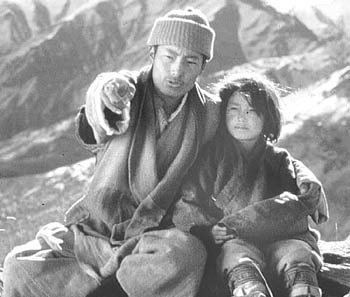![[MetroActive Movies]](/gifs/movies468.gif)
[ Movies Index | Show Times | San Jose | MetroActive Central | Archives ]
Yak Attack
Lumbering gracefully through 'Himalaya'
By
TAKE A PIECE of paper. Draw a straight line from the upper-left corner to the lower-right. Now draw a few silhouettes--rural peasants, rickety wagons, a handful of yaks--each figure making its way upward along the line.
And there you have it.
That's filmmaker Eric Valli's favorite shot, and in his gloriously visual, Oscar-nominated film Himalaya--the epic adventure of an annual yak caravan making its way through the mountains of Nepal to trade salt for grain--the French-born former documentarian uses that shot over and over and over again.
This is not a bad thing, though some critics have accused the film of "visual redundancy." Some have gone so far as to call it boring, and if Himalaya were a movie about car racing, they might be right.
But, in fact--this being a story of Nepalese yak farmers on a salt trek--the constant repetition of imagery becomes one of the film's most powerful tools, reflecting both the beautiful monotony of the Himalayan landscape and the mindset of those who live there. The people of the Dolpopo region--where Himalaya was painstakingly filmed--spend their entire lives on a slope, their day-to-day existence literally an uphill battle.
Tinle (Thinlen Lhondup) is the tenacious, elderly chieftain of a tiny village high in the Himalayas. His son, who had been expected to become the next chieftain, was killed on the most recent trek. When the brave young Karma (Gurgon Kwap) is chosen by the city's holy men to lead the next caravan, Tinle objects, insisting on leading treks himself until his grandson, Tsering (Karma Wangiel), is old enough to take over the job.
Impatient with the Himalayan tradition that would choose the date of the trek according to the movements of the stars, Karma forms a group of caravaners and sets out before the chosen date.
Unwilling to see Karma force his way into leadership, Tinle pulls together another caravan to give chase, enlisting Tsering, his dead son's wife, Pema (Lhakpa Tsamchoe), and his other son, Norbou (Karma Tenzing Nyima Lama), a Tibetan Buddhist lama who has not been outside his monastery since the age of 9.
Along the way, the adventurers face punishing trails, blinding storms, and a generational clash that will ultimately decide the future of the entire tribe.
Then there are the yaks.
Among Himalaya's many cinematic treasures is its numerous shots of yaks loping along in surprisingly graceful motion. Until now, my own yak-awareness has been limited to a drawing of a yak that represented the letter Y in a kindergarten alphabet book. In Himalaya, with its opening shots of a yak herd thundering breathless down a dusty mountainside, the mighty yak appears to resemble something out of a Star Wars movie, alien and vaguely unreal.
By the end of the film, however, we come to love and respect the yak for its courage and sure-footedness, if not for its apparently limited brains. One nail-biting sequence in which Tinle leads the caravan along a sheer cliff-side as the ground crumbles under their feet stands as evidence of these qualities. In fact, one could say that Himalaya does for yaks what Dances with Wolves did for buffaloes.
In its best moments--the tension-filled cliff scene, a cryptic debate between the village astrologers, a shocking funeral service involving dismemberment and vultures--Valli's film provides a peek into a world as mysterious as it is breathtakingly beautiful. It may move at a glacial pace at times, but Himalaya is nevertheless a remarkable film, as elegant and graceful as a single line on a piece of paper.
[ San Jose | MetroActive Central | Archives ]
Copyright © 2001 Metro Publishing Inc. MetroActive is affiliated with the Boulevards Network.
For more information about the San Jose/Silicon Valley area, visit sanjose.com.
![]()

Uphill battle: Gurgon Kwap and Karma Wangiel fight the elements.
'Himalaya' opens Friday, April 6, at Rialto Cinemas Lakeside in Santa Rosa (707/525-4840) and the Rafael Film Center in San Rafael (415/454-1222). For details, see Movie Times.
From the April 5-11, 2001 issue of Metro, Silicon Valley's Weekly Newspaper.